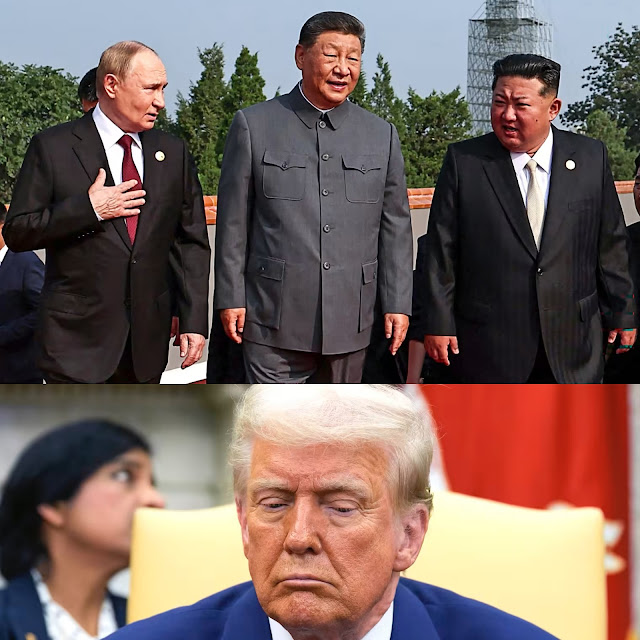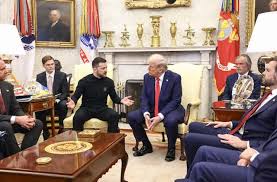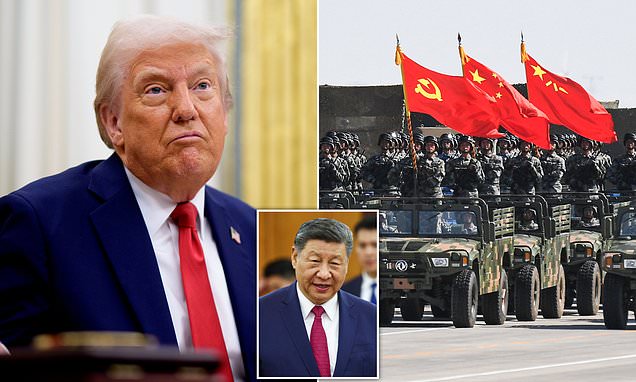On September 4, 2025, China issued a firm rebuttal to claims by U.S. President Donald Trump that it was conspiring with Russia and North Korea against the United States during World War II commemorations in Beijing. The accusation, made via a post on Trump’s Truth Social platform, came as Chinese President Xi Jinping hosted Russian President Vladimir Putin and North Korean leader Kim Jong Un at a massive military parade marking the 80th anniversary of victory over Japan and the end of World War II. The Chinese foreign ministry, through spokesman Guo Jiakun, dismissed the claims, emphasizing that the event was a commemoration of history and not a political alliance aimed at any third party. This incident has sparked a global debate about the evolving relationships among China, Russia, and North Korea, the implications for U.S. foreign policy, and the broader dynamics of international relations in an increasingly polarized world. This article provides an in-depth exploration of the event, the geopolitical context, the responses from all parties involved, and the potential ramifications for global stability.
The Incident: Trump’s Accusation and China’s Response
The controversy began on September 3, 2025, when President Trump posted on Truth Social, addressing Chinese President Xi Jinping directly: “May President Xi and the wonderful people of China have a great and lasting day of celebration. Please give my warmest regards to Vladimir Putin, and Kim Jong Un, as you conspire against The United States of America.” The post was a reaction to a high-profile military parade in Beijing’s Tiananmen Square, where Xi, Putin, and Kim stood side by side, observing a display of China’s military might, including hypersonic missiles, drones, and fighter jets. The event, attended by 26 heads of state, was the first time the three leaders appeared together publicly, prompting speculation about a strengthening “Axis of Upheaval” among the trio’s nations.
China’s response was swift and measured. On September 4, 2025, Chinese foreign ministry spokesman Guo Jiakun addressed Trump’s remarks during a press briefing, stating, “Foreign guests were invited to remember history, cherish the memory of the martyrs, cherish peace, and create the future. China’s diplomacy is never directed against any third party.” This statement aimed to defuse tensions by framing the parade as a historical commemoration rather than a political maneuver. Guo’s comments were echoed by Russian presidential aide Yuri Ushakov, who suggested that Trump’s accusation might have been “ironic,” asserting, “No one was plotting [against the U.S.], no one was weaving anything, no conspiracies.” North Korea, through its foreign ministry official Kim Chon Il, issued a separate statement denouncing the U.S. and its allies, Japan and South Korea, for their “anachronistic and malicious hostile acts” against the DPRK.
The exchange highlights the delicate balance of diplomacy in a world where public statements, particularly on social media, can escalate tensions rapidly. Trump’s provocative language, combined with the high-profile nature of the Beijing parade, has brought renewed attention to the relationships among China, Russia, and North Korea, as well as the United States’ role in countering what it perceives as a growing challenge to its global influence.
The Beijing Parade: A Display of Power and Unity
The military parade in Beijing on September 3, 2025, was a meticulously orchestrated event designed to mark the 80th anniversary of Japan’s surrender in World War II and to showcase China’s growing military and geopolitical clout. Held in Tiananmen Square, the parade featured tens of thousands of troops, advanced weaponry, and a ceremonial release of 80,000 doves, symbolizing peace. The presence of Vladimir Putin and Kim Jong Un, alongside other leaders from Southeast Asia, Central Asia, and Iran, underscored China’s ambition to position itself as a central player in a multipolar world order.
The parade was not merely a commemoration but a deliberate display of strength and unity. Xi Jinping, standing at the center of the event, delivered a speech warning that China was “unstoppable” and that the world faced a choice between “peace and war.” The inclusion of hypersonic missiles, nuclear-capable weapons, and a new laser weapon system signaled China’s advancements in military technology, while the presence of Putin and Kim highlighted deepening ties among the three nations. Analysts, such as Joseph Torigian from American University, noted that the event served as a platform for China and Russia to align their historical narratives, presenting World War II as a shared sacrifice that justifies their demand for a greater role in global governance.
The absence of high-level representatives from major Western democracies, including the United States, was conspicuous. This absence underscored the growing divide between Beijing and the West, particularly over issues such as Russia’s war in Ukraine and China’s neutral stance on the conflict. The parade also featured leaders from countries like Iran, which has provided military support to Russia, and several Southeast Asian and Central Asian nations, signaling China’s success in strengthening regional partnerships. Ryan Hass, director of the John L. Thornton China Center at the Brookings Institution, observed, “Xi is driven to gain acceptance of China as a central global power and to revise the international system to better suit China’s preferences.”
The Geopolitical Context: An Emerging “Axis of Upheaval”
Trump’s accusation of a conspiracy reflects broader concerns about the growing alignment among China, Russia, and North Korea, often described by analysts as an “Axis of Upheaval.” This term, coined by observers like Edward Howell from the University of Oxford, captures the trio’s shared interest in challenging U.S. dominance and reshaping the global order. The relationships among these nations have deepened in recent years, driven by mutual strategic interests and a shared opposition to Western sanctions and influence.
China-Russia Relations: Since declaring a “no limits partnership” in 2022, China and Russia have strengthened their economic and military ties. China has provided an economic lifeline to Russia by purchasing its oil and gas, defying Western sanctions imposed over the Ukraine war. Beijing has also supplied dual-use technologies, such as drones and electronics, that have supported Russia’s military efforts. The two countries have conducted joint military exercises and coordinated on international platforms like the Shanghai Cooperation Organization (SCO), where they were joined by Indian Prime Minister Narendra Modi in Tianjin in September 2025.
China-North Korea Relations: China’s relationship with North Korea has also grown closer, particularly as Pyongyang has deepened its military cooperation with Moscow. Since October 2024, North Korea has sent approximately 13,000 troops to support Russia’s war in Ukraine, along with conventional weapons. South Korea’s intelligence services estimate that around 2,000 North Korean troops have been killed in the conflict. The Beijing parade, attended by Kim Jong Un and his daughter Kim Ju-ae, who is considered a potential successor, underscored China’s implicit support for North Korea’s regime, despite international sanctions over its nuclear program.
Russia-North Korea Relations: The strengthening ties between Russia and North Korea have added another layer to this geopolitical alignment. In June 2024, Putin visited Pyongyang, where he and Kim signed a mutual defense pact, further solidifying their partnership. North Korea’s provision of troops and weapons to Russia has raised concerns in the West about the emergence of a coordinated bloc challenging U.S. and NATO interests.
Trump’s Truth Social post was not the only criticism of the Beijing parade. The European Union’s top diplomat, Kaja Kallas, described the gathering of Xi, Putin, and Kim as part of efforts to build an anti-Western “new world order” and a “direct challenge to the international system built on rules.” This sentiment reflects growing anxiety in Western capitals about the consolidation of authoritarian regimes and their potential to destabilize global norms.
Trump’s Mixed Messages: Diplomacy and Provocation
Trump’s response to the Beijing parade was characteristically provocative, blending congratulatory language with accusations of conspiracy. His post highlighted the historical role of the United States in supporting China during World War II, noting, “Many Americans died in China’s quest for Victory and Glory. I hope that they are rightfully Honored and Remembered for their Bravery and Sacrifice!” This reference to U.S. contributions during the war, particularly through the lend-lease program and the efforts of the Flying Tigers, was a reminder of America’s historical sacrifices, juxtaposed with his claim of a modern-day conspiracy.
However, Trump’s tone shifted later that day during remarks in the Oval Office, where he downplayed concerns about the China-Russia-North Korea alignment. “I have a very good relationship with all of them, with China,” he told reporters, adding, “I thought it was a beautiful ceremony; it was very impressive, but I understood the reason they were doing it: they were hoping I was watching, and I was watching.” This apparent U-turn reflects Trump’s unpredictable approach to diplomacy, which often combines confrontational rhetoric with efforts to maintain personal relationships with world leaders.
Trump’s comments also touched on his frustration with Xi’s failure to acknowledge U.S. contributions during the parade’s speech. “When they did what they did, I thought it was very, very impressive, but I understood the reason they were doing it,” he said, suggesting that the parade was a deliberate show of strength aimed at the U.S. His remarks underscore the delicate balance he seeks to strike between projecting strength and pursuing diplomatic engagement, particularly with Putin, with whom he has been attempting to broker peace talks in Ukraine.
China’s Diplomacy: A Balancing Act
China’s response to Trump’s accusation was carefully calibrated to avoid further escalation while reinforcing its narrative of peaceful intent. Guo Jiakun’s statement that the parade was about “remembering history” and “cherishing peace” aligns with China’s broader diplomatic strategy of presenting itself as a responsible global power. Beijing has consistently emphasized that its relationships with Russia and North Korea are not directed against any third party, a stance reiterated during the press briefing.
However, China’s actions tell a more complex story. The parade’s guest list, which included leaders from Iran and several anti-Western states, and the absence of Western representatives signal a clear alignment with nations challenging U.S. hegemony. Xi’s speech, with its warning that China is “unstoppable,” was interpreted by some analysts as a direct message to the U.S. and its allies. The inclusion of advanced weaponry, such as the Dongfeng-61 hypersonic missile and the LY-I combat laser system, further underscored China’s military ambitions.
China’s relationship with North Korea adds another layer of complexity. The announcement of upcoming bilateral talks between Xi and Kim, aimed at boosting “strategic communication, governance exchange, and cooperation,” suggests a deepening partnership. This move comes as North Korea faces increasing international isolation due to its nuclear program and its support for Russia’s war in Ukraine. China’s support for Kim’s regime, while carefully framed as diplomatic engagement, raises questions about its commitment to international sanctions and non-proliferation efforts.
Russia and North Korea: Deflecting and Defiant
Russia’s response to Trump’s accusation, delivered by Yuri Ushakov, sought to downplay the controversy while acknowledging Trump’s influence on global affairs. Ushakov’s suggestion that Trump’s comment might have been “ironic” reflects Moscow’s desire to avoid a direct confrontation with the U.S. while maintaining its strategic partnership with China. Putin’s presence at the parade, alongside his recent engagements with Xi and Kim, underscores Russia’s pivot toward Asia as it faces Western sanctions and isolation over Ukraine.
North Korea’s reaction was more confrontational. Kim Chon Il’s statement denounced the U.S., Japan, and South Korea, accusing them of “malicious hostile acts” against the DPRK. This rhetoric is consistent with North Korea’s long-standing narrative of external threats, used to justify its military buildup and nuclear ambitions. Kim Jong Un’s attendance at the parade, accompanied by his daughter Kim Ju-ae, was a rare public appearance, signaling both domestic and international audiences of the regime’s resilience and alliances.
Implications for U.S. Foreign Policy
The Beijing parade and Trump’s accusation highlight the challenges facing U.S. foreign policy in a rapidly shifting global landscape. The strengthening ties among China, Russia, and North Korea pose a strategic dilemma for the U.S., which must balance deterrence with diplomacy. Trump’s second term, which began in January 2025, has prioritized expanding the Abraham Accords and countering China’s influence, but his personal approach to diplomacy—marked by direct engagement with leaders like Putin and Xi—complicates these efforts.
The U.S. has responded to the China-Russia-North Korea alignment with increased sanctions and military support for allies like Japan and South Korea. In September 2025, the U.S. imposed 50% tariffs on India for purchasing Russian oil, signaling its intent to curb economic support for Moscow. However, the effectiveness of such measures is limited by China’s role as a major buyer of Russian energy and a supplier of dual-use technologies.
The parade also raises questions about the U.S.’s ability to influence China’s actions. While Trump has emphasized his “very good” relationship with Xi, his provocative rhetoric risks alienating Beijing at a time when cooperation on issues like climate change and global trade is critical. The absence of U.S. representatives at the parade underscores the growing divide between Washington and Beijing, with implications for future diplomatic engagements.
The Global Perspective: A Multipolar World
The Beijing parade and the ensuing controversy reflect broader trends in global politics, particularly the shift toward a multipolar world. China’s emergence as a global power, coupled with Russia’s defiance of Western sanctions and North Korea’s nuclear ambitions, challenges the U.S.-led international order. The parade’s guest list, which included leaders from Iran, India, and several Central Asian states, highlights China’s efforts to build a coalition of nations aligned with its vision of global governance.
For the international community, the incident underscores the need for diplomatic engagement to prevent further escalation. The United Nations, which has struggled to address conflicts like Ukraine and tensions over North Korea’s nuclear program, faces challenges in mediating between major powers. The growing alignment among authoritarian states raises concerns about the erosion of international norms, particularly around human rights and non-proliferation.
Conclusion
China’s denial of conspiring with Russia and North Korea against the U.S., in response to Trump’s accusation, is a snapshot of a world grappling with competing visions of power and influence. The Beijing parade, with its display of military might and high-profile guests, was a deliberate assertion of China’s global ambitions, while Trump’s provocative rhetoric highlighted the fragility of U.S. relations with its adversaries. The responses from China, Russia, and North Korea reflect their shared interest in challenging Western dominance, even as they navigate their own internal and external pressures.
As the world watches this unfolding drama, the incident serves as a reminder of the complexities of modern diplomacy. The relationships among China, Russia, and North Korea, while not necessarily a formal “conspiracy,” represent a strategic alignment that will shape global politics for years to come. For the U.S., the challenge is to balance confrontation with engagement, leveraging its alliances and economic power to counter the growing influence of this “Axis of Upheaval” while avoiding a descent into open conflict.






